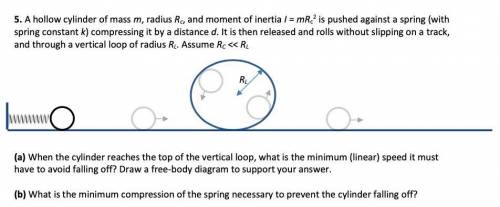
Physics, 02.11.2020 07:30 jocelynm0611
5. A hollow cylinder of mass m, radius Rc, and moment of inertia I = mRc2 is pushed against a spring (with spring constant k) compressing it by a distance d. It is then released and rolls without slipping on a track, and through a vertical loop of radius RL. Assume RC << RL
(a) When the cylinder reaches the top of the vertical loop, what is the minimum (linear) speed it must have to avoid falling off? Draw a free-body diagram to support your answer.
(b) What is the minimum compression of the spring necessary to prevent the cylinder falling off?
(c) Perform two “Cross-checks” on you solutions to check the validity of your solution, and/or examine the behavior of the system.


Answers: 3
Another question on Physics

Physics, 21.06.2019 23:30
Which lists the main components of darwin’s theory of evolution? a. random mutations drive evolution; the evolution of a population happens slowly; organisms have common ancestors; organisms do not change. b. natural selection drives evolution; the evolution of a population happens slowly; organisms have common ancestors; organisms change over time. c. natural selection drives evolution; the evolution of a population happens rapidly; organisms have common ancestors; organisms change over time. d. random mutations drive evolution; the evolution of a population happens rapidly; organisms have common ancestors; organisms do not change.
Answers: 1

Physics, 21.06.2019 23:40
Avalue that describes how heavy an object is and is related to the force of gravity is
Answers: 1

Physics, 22.06.2019 12:20
What is the coefficient of kinetic friction μk between the block and the tabletop?
Answers: 1

Physics, 22.06.2019 12:30
Apositive charge moves in the direction of an electric field. which of the following statements are true? check all that apply. check all that apply. 1.the potential energy associated with the charge decreases. 2. the electric field does positive work on the charge. 3. the electric field does negative work on the charge. 4. the potential energy associated with the charge increases. 5. the electric field does not do any work on the charge. 6. the amount of work done on the charge cannot be determined without additional information.
Answers: 1
You know the right answer?
5. A hollow cylinder of mass m, radius Rc, and moment of inertia I = mRc2 is pushed against a spring...
Questions

Mathematics, 06.04.2020 05:28


Mathematics, 06.04.2020 05:28


Mathematics, 06.04.2020 05:28



English, 06.04.2020 05:29


Social Studies, 06.04.2020 05:29

Chemistry, 06.04.2020 05:29

Mathematics, 06.04.2020 05:29


Mathematics, 06.04.2020 05:29

Mathematics, 06.04.2020 05:29



English, 06.04.2020 05:30


Social Studies, 06.04.2020 05:30



